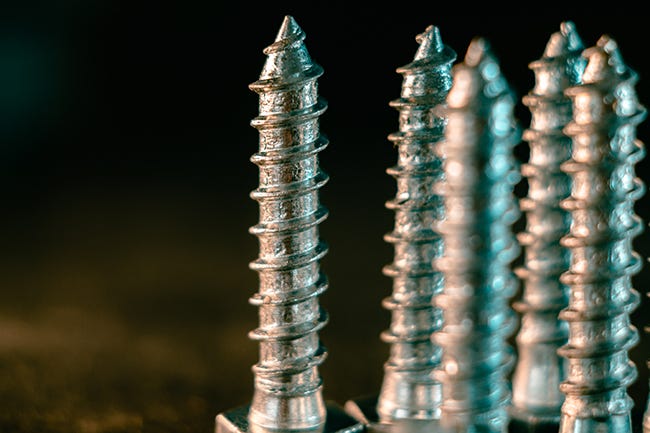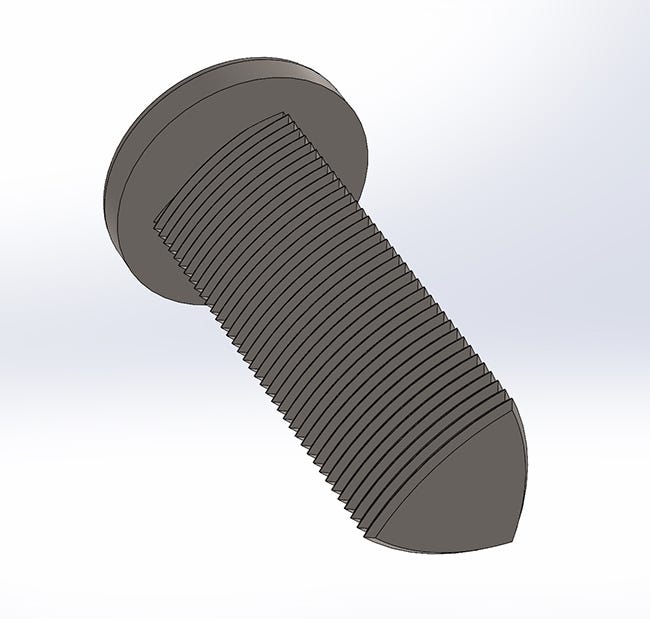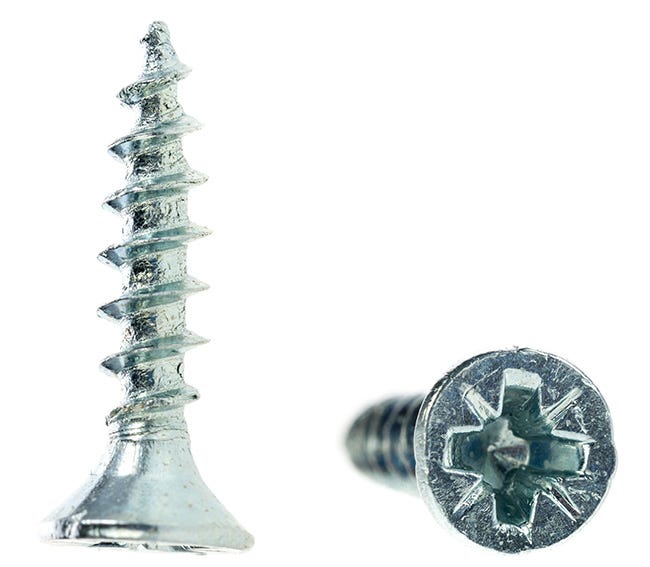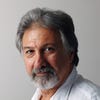Plastic Part Design: Selecting Appropriate Screw Fasteners
In the first of this two-part series, design engineer Michael Paloian details key considerations in specifying screw fasteners for plastics, including the type of screw, size, length, and material.
April 15, 2024

At a Glance
- The Type 25 self-cutting screw is the preferred screw type for plastics.
- To determine screw size, load-bearing requirements should be the first priority.
- Standardized screw type and length improve design for manufacturing and minimize assembly error.
One of the greatest advantages of designing plastic parts is the vast number of assembly options a designer can apply to his or her design. The most common among these options is the use of screws. This article will focus on the considerations you should take into account when specifying a screw fastener for plastics.
The most important considerations in selecting a screw fastener for plastics are:
Screw type
Screw size
Screw length
Screw material
Type of plastic
Residual contaminants on screws
Locking adhesives
Use of washers
Part geometry
Screw torque settings
In this article, we will review the first five considerations in more detail. Stay tuned for part two, which will cover the other five.
Screw type
Hundreds of different screw types are available today, especially when we account for specialty and custom screws, but they can be classified by thread and head type.
Threads either are typically segregated as machine screws, offered in Imperial (English/American) and metric, or thread-forming screws, offered as self-cutting or self-forming versions. Machine screws are often used in applications requiring repeated assembly and disassembly. Mating holes require preformed threads in the plastic or, more commonly, threaded inserts. Inserts are most often specified for machine screws. These inserts are frequently ultrasonically inserted; they are less often molded in. In certain instances, threads are directly included in the plastic part as molded-in threads or post-molded tapping operations. The latter is more popular, since molded-in threads will complicate the mold and add to the overall tooling budget. Threaded holes within an injection molded plastic part are often preferred if the part is subjected to corrosive chemicals. Machine screws can also be tightened to a higher torque level than self-cutting/forming screws.
There are a variety of self-tapping and self-forming screws, which are specifically designed to tap their own threads into the plastic. Thread-forming screws (Figure 1) displace the material without removing it, creating a more secure fit that can resist loosening caused by vibration.

Figure 1. Thread-forming screws. Wirestock/iStock via Getty Images.
Self-forming screws are ideally suited for low-modulus plastics like polyolefins, while thread-cutting screws are ideally suited for medium- to high-modulus thermoplastics as well as thermosets. Thread-cutting screws are specified as Type 23 and Type 25.
The Type 23 self-cutting screw:
Features a thread-cutting tip, often referred to as a "thread-cutting screw."
Is specifically designed for cutting threads in hard materials.
Has a sharp point and a cutting slot that allows it to tap its own hole as it is driven into the material.
Is commonly used in applications where the screw needs to cut into the material, providing a secure fit without the need for a pre-tapped hole.
The Type 25 self-cutting screw (preferred choice for plastics; Figure 2):
Also known as a "thread-forming screw for plastic," it has a wider angle thread and is specifically designed for use in plastics.
Has a blunt point compared with the Type 23, and the threads are designed to form and work well within softer materials without causing stress or damage.
Displaces material around the pilot hole, allowing for a secure fit without cutting into the material, thus reducing the risk of cracking or damaging the plastic.

Figure 2. Type 25 self-cutting screw. Image courtesy Michael Paloian.
Self-tapping screws typically are specified for plastics with moduli ranging from 200 to 400 kpsi (1380 to 2760 MPa). Self-forming screws are not recommended for higher-modulus plastics because of excessively high induced stresses and higher driving torques.
There are numerous versions of self-forming screws that are identified by trade names, such as Plastite, Hi-Lo (Figure 3), and Taptite (Figure 4).

Figure 3. Hi-Lo self-forming screw. Image courtesy of Michael Paloian.
The main difference between self-forming screws intended for use with plastics versus those used for metal or wood is the angle of the thread profile. Thread files for thread-forming screws are much shallower than those for sheet metal. The thread profile for plastic screws is typically 30 degrees, which induces much lower stress into the plastic than a broader angle.

Figure 4. Taptite self-forming screw. Image courtesy of Michael Paloian.
Since the plastic is cold-formed as the screw is inserted, softer plastics are better suited for these types of screws. Stiffer plastics would require much higher driving torque as well as less thread engagement.
Screw size
Screw sizes are defined by screw diameter and pitch. Specifying size is typically based on loads, part size, and components that are to be supported. Metric machine screws are defined as M3, M3.5, M4, M4.5, etc. The number designates the major diameter of the thread in millimeters. Sometimes metric screws also include pitch with the designation M4-0.7 or M5-0.8. The number after the dash represents the number of threads per mm. Imperial machine screw sizes below ¼-inch-diameter are defined with a number and pitch. Examples include 4-40, 6-32, 8-32, 10-24, and 10-32. These numbers range from 0000 to as high as 14, which is equivalent to a ¼-20 screw. Self-forming and Type 25 self-cutting range in size from #2 to #16, but the most common sizes range from #4 to #8.
Load-bearing requirements should determine screw size as a first priority. The second consideration is part size and allocation of available space for the screw. In many cases, screws are required to fasten components such as motors, PCBs, or other purchased items with predefined mounting holes. In such instances, screws are specified by the provided hole sizes.
Screw length
Another consideration for specifying screws is the length of thread engagement. Greater thread engagement equates to higher load capacity. Self-tapping and forming screws can be stripped of their threaded holes if enough tensile force is applied and thread engagement is minimized. The mode of failure is shear stress, at which time the plastic between each thread is sheared away. Therefore, increased thread engagement decreases the stresses in the plastic, increasing load-carrying capabilities. In certain applications where safety and performance are critical, it is recommended to calculate the minimum thread engagement and verify the calculations with tests. Calculations can be determined manually or by applying finite element analysis (FEA).
In many circumstances, screw length is limited by space restrictions. If restrictions limit thread engagement to a few millimeters or fractions of an inch, it may be necessary to modify the design, adding more room or implementing an alternative fastening method.
It’s good design practice to standardize screws in an assembly. Standardized screw type and length improve design for manufacturing (DFM) and minimize assembly error. This preference usually dictates an optimal screw for the entire assembly based on some design trade-offs.
Pull-out strength of machine screws mating to inserts is dependent on the type of insert and insert length. As stated earlier, inserts are most often ultrasonically inserted into injection molded parts. Retention force limits are based on the plastic material, type of insert, and the insert length.
Screw head
Screws are offered in a number of common standard head designs as well as countless custom head varieties. One important consideration when selecting a screw for plastic is stress. The pressure under the head of the screw is a function of tightening torque and screw head size. It’s therefore recommended to specify screws with as big a head as possible. Avoid screws designed for countersunk holes (Figure 5) or those with very small heads like some cap screws (Figure 6). Countersunk screws (Figure 7) induce very high hoop stresses into plastic as they are tightened, which can result in stress cracking and part failure. These types of screws are, therefore, not recommended for plastic parts.

Figure 5. Screws designed for countersunk holes. Dula Ribar/iStock via Getty Images.

Figure 6. Cap screw. ChubarovY/iStock via Getty Images.

Figure 7. Countersunk screw. Nik Bernadsky/iStock via Getty Images.
Pan-head screws (Figure 8) or screws with integral washers are preferred because the larger surface area distributes forces over a larger surface area, reducing stresses.

Figure 8. Pan-head screw. Image courtesy of Michael Paloian.
Screw material
Zinc-plated screws are the most commonly specified screws for plastics because of their low cost and performance. These screws are ideal for applications that are not subjected to corrosive chemicals or harsh environments.
Stainless steel is usually the material of choice for medical devices, marine products, and products that are otherwise prone to rusting during outdoor exposure.
Other materials include polymer coatings, chrome and nickel plate, and black phosphate coatings. Machine screws are also offered in plastic materials such as PVC, nylon 66, and polyurethane. These injection molded screws are often specified for highly corrosive applications where all metals will corrode. It’s important to note that the type of plastic specified for the screw should be selected based on its compatibility with the chemicals it will be exposed to. Other considerations should include tensile strength, impact strength, heat distortion temperature, and creep resistance.
Hang tight: Part 2 of this series is coming soon.
About the Author(s)
You May Also Like




